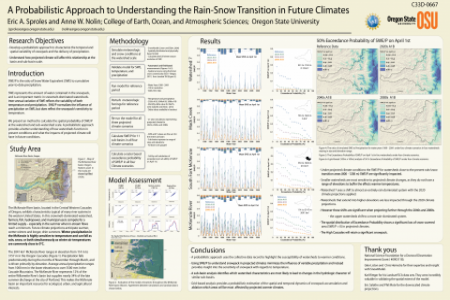Snowpack in the maritime climate of the Western Oregon Cascades is highly sensitive to temperature. Projected future warming in the region would shift the present rain-snow transition zone up in elevation, resulting in a diminished snowpack for this snow-dominated system. We present a probabilistic approach to characterize the temporal and spatial variability of snowpack and the delivery of precipitation in both present and projected climates. The dimensionless ratio of Snow Water Equivalent (SWE) to cumulative precipitation (P; with the ratio referred to as SWE/P hereafter) minimizes the effects of variable precipitation, while still accounting for the impacts of warmer temperatures on snowmelt. In the McKenzie River Basin in the Western Oregon Cascades, SWE/P was calculated from distributed modeled results. These results were compiled at monthly, seasonal, annual, and multi-year time steps for water years 1990 – 2011. This temporal range includes seasons with above average, normal, and below average precipitation and ones influenced El Niño/La Niña-Southern Oscillation (ENSO) events. For the future climate scenarios, the meteorologic model inputs (specifically temperature and precipitation) were perturbed using statistically downscaled regional climate projections through 2099 as described in the IPCC-AR4. The cumulative and exceedence probabilities of SWE/P were calculated for twelve sub-watersheds of the McKenzie River and for each 100m-grid cell of the model domain in present and projected climate conditions. This probabilistic approach highlights which sub-basins would be most affected by projected warmer climates. The grid-based calculations provide a probabilistic estimation of where the spatial and temporal dynamics of snowpack accumulation and ablation will be most affected by projected warmer climates. This knowledge helps improve the understanding of precipitation and snowmelt, both of which are first-order contributors to streamflow. Additionally, it provides an informed analysis to help locate sites for an improved snow and meteorologic monitoring network.


